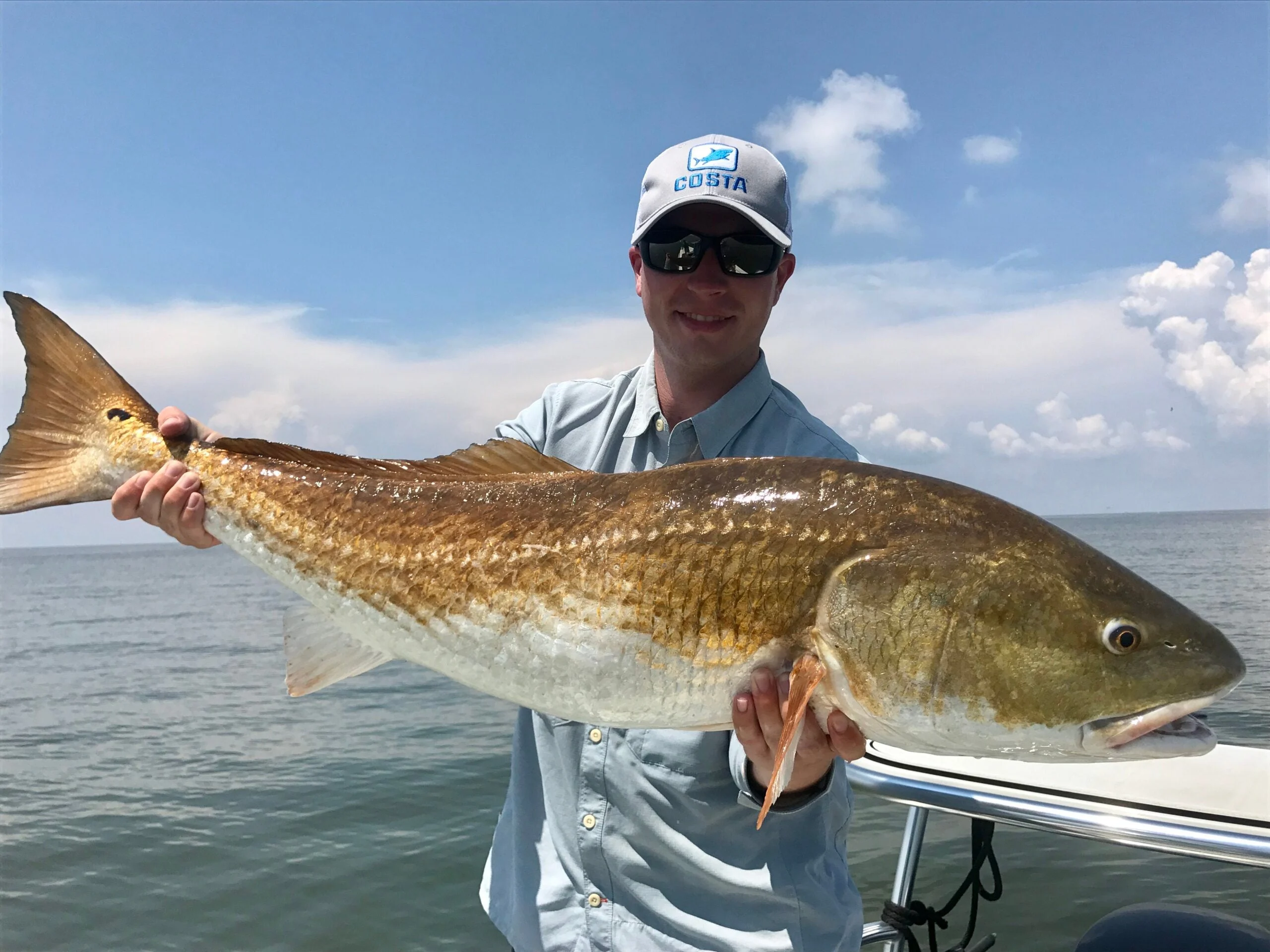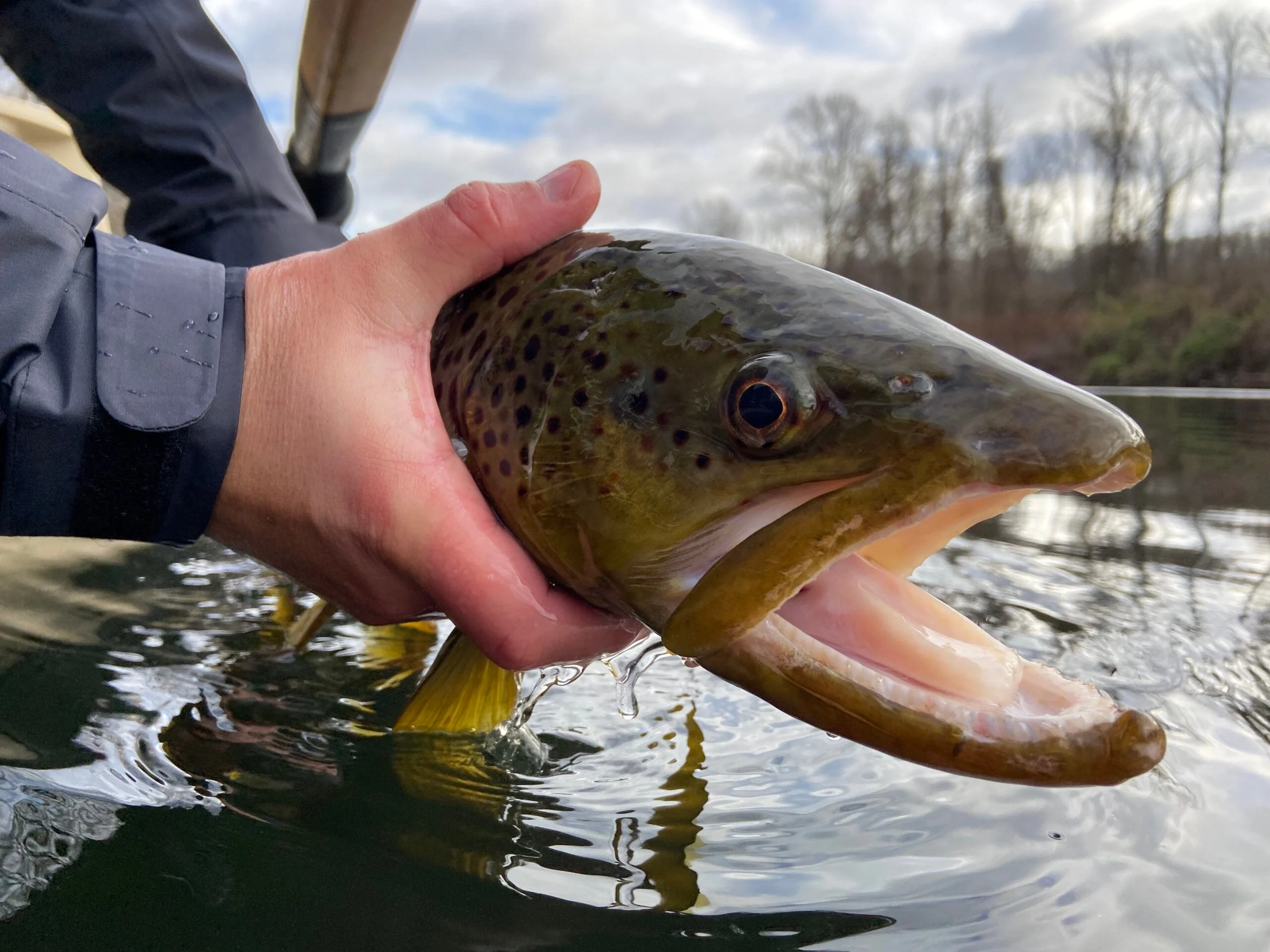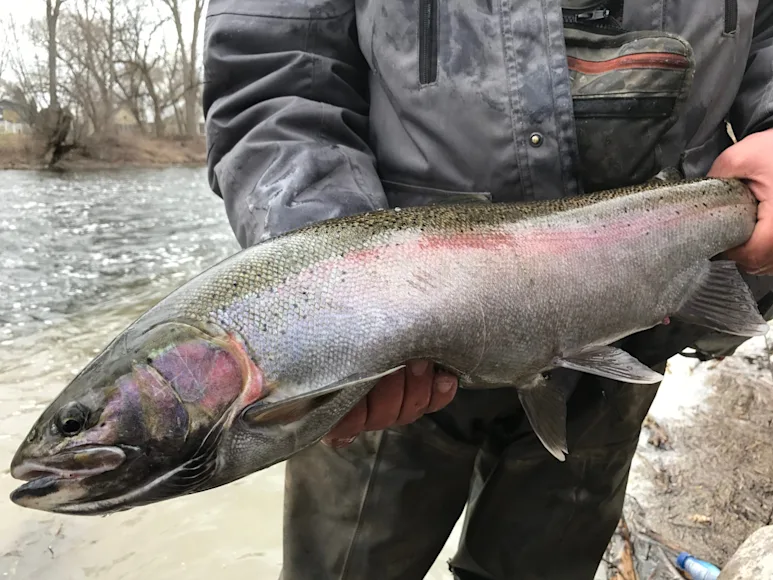Traveling in winter isn’t always fun. You’ve got to worry about flight delays, blizzards, icy roads, and wind. None of those things, however, are in your control, so you shouldn’t let them sway a decision to plan a trip on any of these best winter fishing destinations. You can control where you go, and if you choose wisely, there’s epic action waiting.
If you think the only place worth going is out on the ice, you couldn’t be more wrong. Winter fishing can be kind of slow in many parts of the country, but certainly not everywhere. Compiled here is a list of the 15 best winter fishing destinations—and yes, some of them are frozen lakes. But others will take you to places where shorts are still in season and the water is warmer than the air. Whether you want to test your chill tolerance or escape the freeze, whether you want to kick back and wait for a bite or work lures and flies all day, there’s a spot here for every type of angler.
Best Winter Fishing Destinations
Venice, Louisiana
Cotter, Arkansas
Pulaski, New York
Lake Champlain, New York/Vermont
Key West, Florida
Miami, Florida
Niagara River, New York
James River, Virginia
Baffin Bay, Texas
Lake Okeechobee, Florida
Devils Lake, North Dakota
San Diego, California
New River, Virginia
South Holston River, Tennessee
Henry’s Fork River, Idaho

1. Venice Louisiana
Target Species: Redfish
Follow Highway 23 along the Mississippi River south of New Orleans until you run out of road, and you’ll find yourself in Venice. This is the last town on the “Ol’ Miss,” and “town” is kind of a strong word. Venice is more of an outpost for two kinds of people—offshore oil rig workers and fishermen. But, despite a low number of restaurant choices and amenities, Venice truly is a sportsmen’s paradise. Although winter weather patterns can bring more windy days than you might see at other times of year, you can expect milder temperatures, often in the 60s.
As the water cools, bull red drum that winter in South Louisiana’s vast marshes often group up in deeper “ponds” and backwaters. It’s not uncommon to experience a sea of copper giants piling on top of one another to feed this time of year, and whether you want to relax and lob a shrimp under a popping cork, or cast and strip flies all day, your arms will hurt by the time you hit the bar each night.
2. Cotter, Arkansas
Target Species: Trout
The little town of Cotter is situated on the bank of the White River, which is arguably one of the most famous tail waters in the United States. Because its flows are controlled by dam releases, it maintains a warmer temperature in winter than other rivers regardless of how low air temperatures plummet. Best of all, you can tailor a visit around any style of trout fishing you like, and how hard you want to work to catch them.
The White is a big river, and it’s absolutely brimming with winter trout. The caveat is they’re not all huge. However, if you want to rack up numbers, all you need is a jig under a float and you can expect to break double digits on smaller rainbows and browns. It’s great for kids, but if you’re more into trophy fishing, putting in the effort to rip big streamer flies or jerkbaits all day can lead to wild browns you measure in pounds, not inches.
3. Pulaski, New York
Target Species: Steelhead
Pulaski can be harsh in winter. It receives more snowfall than most towns in Upstate New York due to its location at the east end of Lake Ontario. That’s why anglers that fish the famed Salmon River here in winter are often referred to as the “chosen frozen.” But, if you can stand the cold, you can be treated to tremendous action with big steelhead.
The beauty of fishing the Salmon in winter is that crowds diminish, but the number of steelhead in the river is at its strongest. Whether you’re into drifting fleas with a fly rod or natural egg sacks with spinning gear, you won’t be jockeying for position as much as you would during the fall. The good thing is, there is no shortage of lodges and motels in town to fit any budget, and when you’re ready to thaw your toes, there are loads of great saloons with warm wood stoves and vast bourbon selections.
4. Lake Champlain, New York/Vermont
Target Species: Lake Trout and Pike
Lake Champlain creates the northern border between New York and Vermont. The biggest lake in the Northeast next to the Great Lakes, Champlain also straggles into Canada. It presents world-class fishing opportunities in the spring, summer, and fall, but if you’re an ice-fishing fanatic, the winter months offer shots and monsters through the ice.
The ice-fishing culture on Champlain is incredibly strong. Each winter, locals and out-of-towners hit the lake in droves to take a crack at its most prized winter targets—lake trout and trophy northern pike. For lakers, your best bet is to focus on deeper areas of the main lake, and jigging action is often fierce near the towns of Port Henry and Westport on the New York side. If it’s pike you’re after, head to the northern end of the lake and set your tip-ups in weedy Missisquoi Bay. Missisquoi is steeped in ice fishing tradition and history, and the pike aren’t small.
5. Key West, Florida
Target Species: Wahoo
First, a quick word of warning: Key West is one of the best winter fishing destinations if you want to feel some 80-degree air on your pale skin, but it’s still winter, and winter often brings windy conditions. So, if you’re planning to fish, book multiple days in case Mother Nature turns on the fan. If you do catch a few days of ideal conditions, however, you can catch more trophy wahoo in a single trip than you ever thought possible.
Winter migration patterns move these pelagic speed demons into Key West waters en masse. Runs are typically not that far offshore, and while trolling is the number one method for catching them, they can occasionally be thick enough to catch on jigs and live baits. Regardless of how you catch them, nothing is sweeter in February than having a local restaurant prepare wahoo sashimi and blackened wahoo from fish you caught and that you can enjoy while kicking back in flip flops as the rest of the country shivers.
6. Miami, Florida
Target Species: Peacock Bass
Looking to spice up your winter with something exotic? Turn up the heat in the Miami area with peacock bass. The vast network of interconnected canals, lakes, and ponds just west of the city are chock full of these South American natives, and if you live in the north and think smallmouth bass fight hard, wait until you tie into one of these bright-green beauties.
The nice thing about peacock bass fishing in this area is that there are several professional outfitters that can get you to prime water via boat if you want to spend the money on their services. Conversely, there is no shortage of public access via parks and trail networks that make DIY foot mission both do-able and productive. Peacock bass are highly aggressive and brutal brawlers, so make sure you bring a reel with a quality drag. Any peacock bass lure you’d use for largemouths and smallmouths—spinnerbait, finesse bait, popper, or jerkbait—will work, just make sure you have a few in bright orange.
7. Niagara River, New York
Target Species: Steelhead, Brown Trout, and Lake Trout
The mighty Niagara is a site to behold, and I’m not talking about the falls. Downriver in the quiet town of Lewiston, New York, millions of gallons of aqua-green water flow by every minute on their way to Lake Ontario. Small whirlpools open and close constantly in this stretch of water. It commands respect, especially in winter, but the payout for bundling up and drifting it this time of year can be huge.
Each fall, piles of steelhead, brown trout, and spawning lake trout flood the lower Niagara. The steelhead and many of the browns and lakers will remain here until early spring. Provided conditions allow you to get out, even on the coldest days you can expect to be warmed to the core by bent rods and screaming drags. Bouncing egg sacks along the bottom scores all three species, often within the same drift. It’s also very possible to hit lakers on swimbaits and jigs, as they often hug the slope of the banks, putting themselves in shallower water than they will any other time of year.
8. James River, Virginia
Primary Target: Blue Catfish
Most people associate catfishing with warm spring days and summer nights. Those are great for cats, but if you really want to land a trophy catfish—like a 50-plus-pound blue—forget the tank top and grab your mittens. Diehard catfishermen in the Mid-Atlantic live for the cold season, because they know conditions will often make true trophies riper for the picking.
Come winter, blue catfish in the James near the town of Hopewell become more predictable. They’ll often pile into holes and behind current breaks, and if you find one, you often found the motherlode. With a reduced willingness to roam around looking for food, winter cats have to take what they can get. Any food source that ends up washing into their winter hidey hole will usually get gobbled in short order. This time of year, true giants are simply less selective and wary, and on the James, landing a fish in the 60- to 80-pound range is a very real possibility.
9. Baffin Bay, Texas
Target Species: Specked Trout
Before heading to the South Texas coast in winter, it’s worth doing a little homework. This region is far enough south that it usually maintains mild temperatures, making it a great pick for a winter fishing destination. However, deep swings of ice-cold air can make it down to Baffin Bay, and they can really slow the fishing, so monitor the conditions before and during a visit. Of course, if patterns have been pretty normal, you can find yourself in gator trout heaven.
This vast inland bay system is rife with shallow flats with dark bottoms that help the water maintain a temperature that will keep speckled trout chewing all winter. In January and February, you’ll often find them along deeper channel edges close to flats. Baffin is world-famous for producing truly monster trout, and in winter they’ll smack almost any speckled trout lure—everything from a Rat-L-Trap, to a soft-plastic finesse fish, to a walking topwater on especially warm days.
10. Lake Okeechobee, Florida
Target Species: Largemouth Bass
Known as “the Big O,” Lake Okeechobee is Florida’s largest inland body of freshwater, encompassing 734 square miles. This lake feeds the Everglades to the south, and features vast expanses of lily pads, reeds, and aquatic vegetation. It’s also shallow, with depths rarely exceeding 12 feet. Factor in that it’s loaded with shad, bream, and crappies, and you’ve got all the protein you need to grow giant largemouth bass.
During the winter months, you can score a 10-pound bass on a wide variety of lures. If the method is less important to you than the end result, however, there is no easier way to nab a trophy this time of year than fishing big live shiners under floats. Every bait shop around the lake has their tanks loaded, because they know that despite warmer temperatures than much of the country, earning big bites on artificials takes focus and persistence now. My advice? Put in your time chucking chatterbaits and swimbaits, and if all else fails, kick back, relax, and wait for a bobber to get ripped under.
11. Devils Lake, North Dakota
Target Species: Walleye and Yellow Perch
At 180,000 acres, Devils Lake is anything but small. What also aren’t small are the perch and walleyes that live in it—which is why it’s one of the best winter fishing destinations in the U.S. Devils has a reputation for kicking out fish with football guts on the regular, and in large quantities to boot. It’s arguably one of the top 3 best destinations for winter walleye in the lower 48, and with all those acres to roam, you can usually bank on finding a productive area all to yourself.
Devils Lake is renowned for the overall health of its fish. This is largely attributed to a thriving population of freshwater shrimp. These high-protein morsels accelerate the growth of the perch. The walleyes eat those protein-rich perch, and they get fat, too. Having a motorized vehicle to get around on the ice is a plus here, though if you are on foot, there are plenty of great bait shops around the perimeter of Devils that can provide maps and point you in the right direction for success.
12. San Diego, California
Target Species: Rockfish, Yellowtail, and Halibut
San Diego might be the perfect place to live. In winter, temperatures rarely dip below 50 degrees and tend to hover in the low 70s during the day. Of course, it costs a fortune to live there, but it’s a heck of a place to visit in winter, especially if you’re looking to take home enough top-shelf saltwater fish fillets to fill the freezer.
This time of year, you don’t have to run very far out of San Diego Harbor to get on the meat. Just off the gorgeous Southern California cliffs, you’ll find various species of rockfish, calico bass, lingering yellowtail kingfish, and you might even luck into a California halibut. The bottom line is that with so much variety, rods will be bent all day. Furthermore, almost everything you catch will make exquisite table fare. Pair those fillets with some of the fresh crab, lobster, and oysters San Diego is known to serve up, and dig in.
13. New River, Virginia
Target Species: Muskies
Sure, the upper Midwest might be considered record muskie territory in this country, but during the winter, all those toothy beasts are locked under the ice. But they’re not in Virginia’s moving water. While the New River presents muskie opportunity all year long, most local muskie maniacs would agree winter is the better time to get after them.
One reason for that is because when the water is cold, the fight and landing process is less stressful on the fish. But that’s just a sugar coating for the whole experience. What matters more is that the location of the fish becomes more predictable in winter, as they tend to move into eddies, soft spots, and deep holes near current breaks. They’re also apt to chew, as meal options can be scarcer in winter. Whether you want to fling a 12-inch fly on a 12-weight rod or work a sexy glide bait on a conventional outfit, there’s a strong chance the New will give you a taker or three.
14. South Holston River, Tennessee
Target Species: Trout
The section of the South Holston from Bluff City, Tennessee, northeast to South Holston Lake is a tremendous tail water. Fed by the discharge from the bottom of the lake, this river maintains higher temperatures in the winter, and it’s also loaded with vegetation that helps aquatic insects and freshwater shrimp thrive year-round. These food sources keep its booming trout population fat and happy, and like most tail waters, you can play for numbers or size.

Nymphing with the fly rod will produce plenty of trout, but if you want the giants, don’t be afraid to throw some big streamers. The South Holston holds monster wild browns, and unlike other tail waters east of the Rockies, it also grows some very large rainbow trout. There are ample options for lodging and outfitters in the Bluff City area, so whether you’re going on a trophy mission with the guys or taking the kids, you can tailor any visit to your trouty desires.
15. Henry’s Fork River, Idaho
Target Species: Trout
Do you lay around all winter daydreaming about big trout sipping your dry flies off the surface? If it’s driving you to madness, don’t wait until spring to visit this spot on our list of the best winter fishing destinations. Head to the Henry’s Fork right now. One of the most famous tailwaters in the American West, volumes have been written about it and its incredible trout fishing. It’s a year-round destination, of course, but if rising trout is what you want, the Henry’s Fork can provide them even on the coldest days.
A big reason why the Henry’s Fork is so famous is because of its prolific bug life, and not all the bugs go to bed after the fall. There’s no denying that this area sees some rough winter conditions, but where the river flows through the Island Park Caldera down to the upper Snake River Plain, a day with temperatures just north of 30 degrees will get midges hatching. Likewise, blue winged olives will hatch here all winter long, and if you catch it right, trout noses will dimple the surface as the feed like it was the middle of July.


